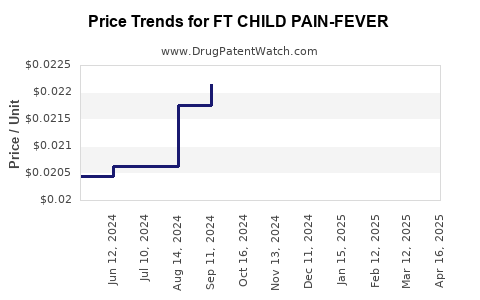Drug Price Trends for FT CHILD PAIN-FEVER
✉ Email this page to a colleague

Average Pharmacy Cost for FT CHILD PAIN-FEVER
| Drug Name | NDC | Price/Unit ($) | Unit | Date |
|---|---|---|---|---|
| FT CHILD PAIN-FEVER 160 MG/5 ML | 70677-1142-01 | 0.02052 | ML | 2024-11-20 |
| FT CHILD PAIN-FEVER 160 MG/5 ML | 70677-1143-01 | 0.02052 | ML | 2024-11-20 |
| FT CHILD PAIN-FEVER 160 MG/5 ML | 70677-1143-01 | 0.02152 | ML | 2024-10-23 |
| FT CHILD PAIN-FEVER 160 MG/5 ML | 70677-1142-01 | 0.02152 | ML | 2024-10-23 |
| FT CHILD PAIN-FEVER 160 MG/5 ML | 70677-1143-01 | 0.02214 | ML | 2024-09-18 |
| FT CHILD PAIN-FEVER 160 MG/5 ML | 70677-1142-01 | 0.02214 | ML | 2024-09-18 |
| FT CHILD PAIN-FEVER 160 MG/5 ML | 70677-1143-01 | 0.02176 | ML | 2024-08-21 |
| >Drug Name | >NDC | >Price/Unit ($) | >Unit | >Date |


